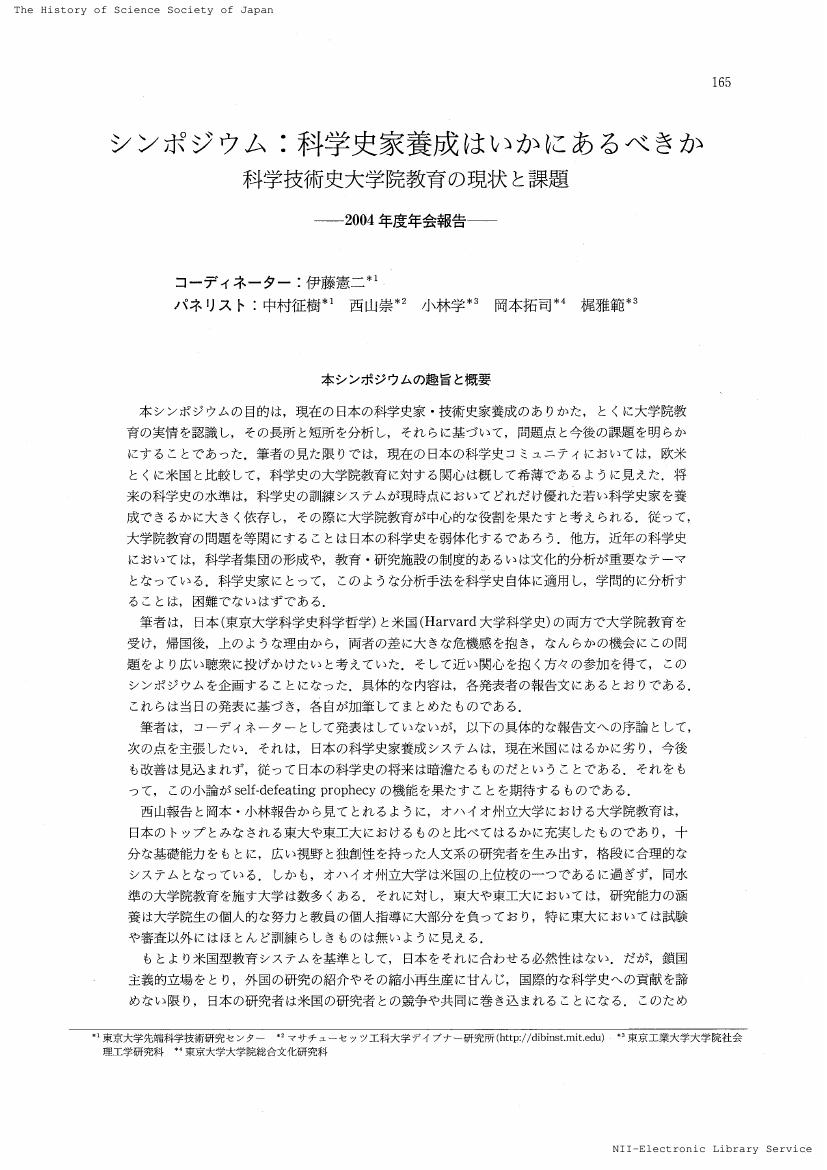- 著者
- 伊藤 一馬
- 出版者
- 内陸アジア史学会
- 雑誌
- 内陸アジア史研究 (ISSN:09118993)
- 巻号頁・発行日
- vol.30, pp.96-97, 2015-03-31 (Released:2017-10-10)
1 0 0 0 恒温植物の熱産生プロセスに関する研究
植物は哺乳動物とは異なり、自らの体温を調節することなく、外界の気温と共にその体温が変動するものと考えられてきた。ところが驚くべきことに、ある種の植物には、自ら発熱し、体温を調節するものが存在する。本研究においては早春に花を咲かせる発熱植物である「ザゼンソウ」に着目し、本植物の熱産生に関わるシステムを明らかにするための研究を行った。はじめに群落地および人工気象室におけるザゼンソウの発熱変動データーを収集し、肉穂花序の恒温維持に関わる特性を検討した。その結果、ザゼンソウの肉穂花序は約60分を1周期とする体温振動を示すことが明らかになった。興味深いことにこの体温振動は、外気温の変動を原因とする体温の変化により引き起こされ、しかも、この体温振動が誘導されるための体温変化の閾値は0.3℃であると見積もられた。植物界でこのような微少温度変化を認識し、恒温性を維持できる生体応答システムはザゼンソウ以外には報告がない。この研究成果は、2001年夏に米国で開催されたアメリカ植物生理学会年次総会で招待講演を行った。次に、このザゼンソウに特徴的な体温振動過程における発熱関連遺伝子のmRNA発現量について検討した。発熱関連遺伝子としては、哺乳動物で非ふるえ熱産生の原因遺伝子であることが明らかになっている脱共役タンパク質(uncoupling Protein : ucp)のザゼンソウホモログ、および、植物の発熱原因遺伝子であるとされているシアン耐性呼吸酵素(alternative oxidase : aox)遺伝子をターゲットとした。特にaox遺伝子は従来ザゼンソウ肉穂花序より単離されておらず、本研究においてその単離を行った。ノーザン解析により、肉穂花序の体温振動過程におけるucpおよびaox遺伝子の発現を調べたところ、それぞれのmRNAの蓄積量には大きな変動がなく、体温の変動は発熱関連遺伝子の転写レベルでは調節されていないことが推察された。
1 0 0 0 OA 国際経済法における価値調整問題と「持続可能な発展」概念
- 著者
- 伊藤 一頼
- 出版者
- 世界法学会
- 雑誌
- 世界法年報 (ISSN:09170421)
- 巻号頁・発行日
- vol.38, pp.27-54, 2019-03-28 (Released:2022-06-06)
1 0 0 0 OA 国策会社 電源開発(株)のダイナミズム ―「大容量海外炭火力の推進」を事例として―
- 著者
- 伊藤 輝美
- 出版者
- 経営史学会
- 雑誌
- 経営史学 (ISSN:03869113)
- 巻号頁・発行日
- vol.53, no.4, pp.3-27, 2018 (Released:2021-03-30)
- 被引用文献数
- 1
The purpose of this paper is threefold: (1) to elucidate why the national power company, Electric Power Development Company (J-POWER) began promoting a business model centered on use of large-scale, overseas-coal-fired thermal power stations, turning back the clock on the energy revolution, wherein Japan, preceding the oil crisis, shifted away from coal to imported oil; (2) to explore why J-POWER succeeded in the commercial operation of the Matsushima Thermal Power Station (500 MW×2 Units) in 1981; and (3) to interrogate why J-POWER challenged the research and development of cutting-edge thermal power technologies like flue gas desulfurization, selective catalytic reduction of NOx, and ultra-supercritical steam generation using boiler-turbines. Nine electric power companies (NEPC) were established by the reorganization of the electric power industry in 1951. NEPC had four key characteristics: private management, vertical integration, nine regional divisions, and monopoly. In 1952, however, J-POWER was founded by a government initiative, The Electric Development Promotion Law, to overcome post-war power shortages and to increase the supply of electricity in Japan following World War II. J-POWER is the only large-scale wholesale power company in Japan that has power stations and a nationwide network of transmission lines that connect each domestic region. NEPC actively developed large-scale, oil-fired power stations during Japan’s energy revolution. Before the oil crisis, the autonomy of NEPC worked well, as an economic and stable electricity supply had been realized. Despite this, J-POWER made an effort to promote a business model employing the large-scale import of coal for coal-fired thermal power stations, to turn back the clock on the energy revolution. After the oil crisis, J-POWER demonstrated that the Matsushima Thermal Power Station could indeed generate more economical electricity than an oil-fired power station. As such, J-POWER aggressively developed power stations fueled by overseas coal on a large scale to supply to NEPC in tune with the needs of the time. Several studies about the Japanese power industry were published and mainly focused on NEPC. These studies recognized coal as a natural resource that had taken a beating by other natural energy sources, such as oil and liquefied natural gas. In doing so, however, these studies disregarded J-POWER’s above-mentioned activities and its role in the energy industry.
1 0 0 0 OA 西牟田祐二著『語られざるGM社─多国籍企業と戦争の試練─』
- 著者
- 伊藤 裕人
- 出版者
- 大阪経済大学日本経済史研究所
- 雑誌
- 経済史研究 (ISSN:1344803X)
- 巻号頁・発行日
- vol.24, pp.195-206, 2021-01-31 (Released:2021-03-15)
1 0 0 0 OA 斎藤幸平『大洪水の前に―マルクスと惑星の物質代謝』堀之内出版,2019 年
- 著者
- 伊藤 誠
- 出版者
- 経済学史学会
- 雑誌
- 経済学史研究 (ISSN:18803164)
- 巻号頁・発行日
- vol.62, no.2, pp.98-99, 2020 (Released:2021-12-19)
- 被引用文献数
- 1
- 著者
- 伊藤 潤
- 出版者
- 国際安全保障学会
- 雑誌
- 国際安全保障 (ISSN:13467573)
- 巻号頁・発行日
- vol.45, no.1, pp.79-96, 2017-06-30 (Released:2022-04-01)
- 著者
- 伊藤 頌文
- 出版者
- 国際安全保障学会
- 雑誌
- 国際安全保障 (ISSN:13467573)
- 巻号頁・発行日
- vol.44, no.4, pp.74-92, 2017-03-31 (Released:2022-04-01)
1 0 0 0 OA 過信のリアリズム試論 ――日ソ中立条約(1941年)を事例として
- 著者
- 伊藤 隆太
- 出版者
- 国際安全保障学会
- 雑誌
- 国際安全保障 (ISSN:13467573)
- 巻号頁・発行日
- vol.44, no.4, pp.58-73, 2017-03-31 (Released:2022-04-01)
1 0 0 0 OA インドにおける政権交代と近隣政策の新展開
- 著者
- 伊藤 融
- 出版者
- 国際安全保障学会
- 雑誌
- 国際安全保障 (ISSN:13467573)
- 巻号頁・発行日
- vol.43, no.1, pp.8-22, 2015-06-30 (Released:2022-04-01)
1 0 0 0 OA 道下 徳成 著『北朝鮮 瀬戸際外交の歴史、1966~2012年』
- 著者
- 伊藤 弘太郎
- 出版者
- 国際安全保障学会
- 雑誌
- 国際安全保障 (ISSN:13467573)
- 巻号頁・発行日
- vol.42, no.2, pp.105-108, 2014-09-30 (Released:2022-04-07)
1 0 0 0 OA 松田 康博 編著『NSC国家安全保障会議―危機管理・安保政策統合メカニズムの比較研究』
- 著者
- 伊藤 剛
- 出版者
- 国際安全保障学会
- 雑誌
- 国際安全保障 (ISSN:13467573)
- 巻号頁・発行日
- vol.38, no.1, pp.100-103, 2010-06-30 (Released:2022-04-14)
1 0 0 0 OA 「カシミール」をめぐるアイデンティティと安全保障観の変容
- 著者
- 伊藤 融
- 出版者
- 国際安全保障学会
- 雑誌
- 国際安全保障 (ISSN:13467573)
- 巻号頁・発行日
- vol.35, no.2, pp.77-95, 2007-09-30 (Released:2022-04-20)
1 0 0 0 OA 安全保障政策に対する多国間アプローチとアメリカ
- 著者
- 伊藤 剛
- 出版者
- 国際安全保障学会
- 雑誌
- 国際安全保障 (ISSN:13467573)
- 巻号頁・発行日
- vol.29, no.2, pp.27-40, 2001-09-30 (Released:2022-04-28)
1 0 0 0 OA 大村藩測量方峰源肋について(科学史入門)
- 著者
- 伊藤 節子
- 出版者
- 日本科学史学会
- 雑誌
- 科学史研究 (ISSN:21887535)
- 巻号頁・発行日
- vol.47, no.246, pp.112-115, 2008 (Released:2021-08-05)
1 0 0 0 OA ガリレオの落下法則(科学史入門)
- 著者
- 伊藤 和行
- 出版者
- 日本科学史学会
- 雑誌
- 科学史研究 (ISSN:21887535)
- 巻号頁・発行日
- vol.47, no.245, pp.32-35, 2008 (Released:2021-08-05)
















